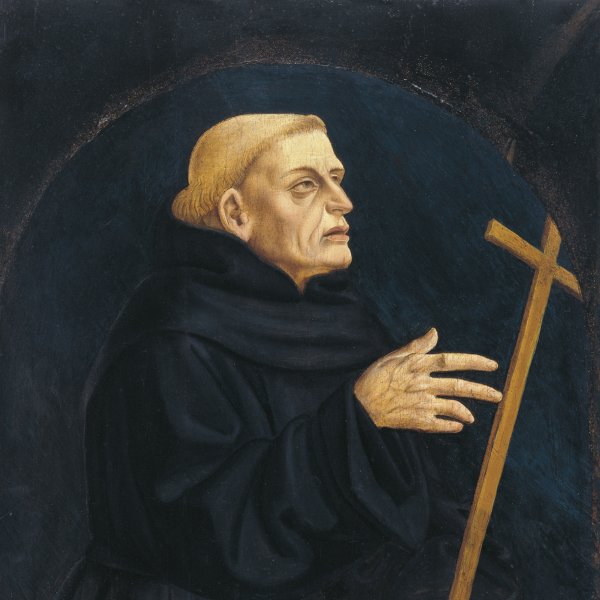Domenico Veneziano
Active in 1438-Florence, 1461
Possibly of Venetian origin, Domenico Veneziano worked for most of his career in Florence and is considered one of the great masters of the Renaissance during the first half of the 15th century. Almost nothing is known of his initial training and the first document that refers to his professional activities is a letter written to Piero de’Medici from Perugia, dated 1 April 1438. It can thus be assumed that by that date the artist had contacts with the most influential families in Florence and Umbria.
Early works include The Virgin and Child enthroned (National Gallery, London), which reveals the influence of Masolino. It has been thought thatthe two artists worked together in Rome between 1428 and 1433, or in Milan around 1433–35. A key element in Veneziano’s style is the influence of the sculpture of Donatello and Luca della Robbia and their classical ideas on beauty, although the principal foundation of his work was the application of perspective to painting, in particularly to landscape. The latter would be of major importance for Piero della Francesca, who is documented as Veneziano’s assistant on a now lost fresco cycle for the choir of San Egidio in Florence, which was continued by Andrea del Castagno. Also dating from this period is the tondo of The Adoration of the Magi (Gemäldegalerie, Berlin). The importance of landscape in Veneziano’s work has been the object of intense study and art historians continue to debate whether this element has its origins in Flemish art, assimilated through a period of training in northern Italy or whether it simply derives from Donatello. In the 1440s Veneziano executed his masterpiece, The Saint Lucy Altarpiece, now divided between the Galleria degli Uffizi, Florence, the National Gallery of Art, Washington, the Gemäldegalerie, Berlin, and the Fitzwilliam Museum, Cambridge. It reveals Veneziano’s careful treatment of the settings, which reflect his knowledge of Florentine Renaissance architecture and in particular the work of Brunelleschi. The figures and colouring become more refined in his late works, which include The Virgin and Child (National Gallery of Art, Washington). Veneziano died in Florence on 15 May 1461.
Early works include The Virgin and Child enthroned (National Gallery, London), which reveals the influence of Masolino. It has been thought thatthe two artists worked together in Rome between 1428 and 1433, or in Milan around 1433–35. A key element in Veneziano’s style is the influence of the sculpture of Donatello and Luca della Robbia and their classical ideas on beauty, although the principal foundation of his work was the application of perspective to painting, in particularly to landscape. The latter would be of major importance for Piero della Francesca, who is documented as Veneziano’s assistant on a now lost fresco cycle for the choir of San Egidio in Florence, which was continued by Andrea del Castagno. Also dating from this period is the tondo of The Adoration of the Magi (Gemäldegalerie, Berlin). The importance of landscape in Veneziano’s work has been the object of intense study and art historians continue to debate whether this element has its origins in Flemish art, assimilated through a period of training in northern Italy or whether it simply derives from Donatello. In the 1440s Veneziano executed his masterpiece, The Saint Lucy Altarpiece, now divided between the Galleria degli Uffizi, Florence, the National Gallery of Art, Washington, the Gemäldegalerie, Berlin, and the Fitzwilliam Museum, Cambridge. It reveals Veneziano’s careful treatment of the settings, which reflect his knowledge of Florentine Renaissance architecture and in particular the work of Brunelleschi. The figures and colouring become more refined in his late works, which include The Virgin and Child (National Gallery of Art, Washington). Veneziano died in Florence on 15 May 1461.





